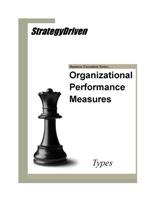Organizational Performance Measures Whitepaper Introduction – Selection

Performance measure selection is of critical importance to an organization because they serve as one of the most powerful drivers of organizational behavior. People respond to performance measures because they clearly establish standards and goals, provide routine and often public feedback, and are both generally and specifically consequential. A properly structured measurement system aligns management decisions and workforce actions to the achievement of the organization’s mission. Structured improperly, performance measures become one of the most destructive forces a company unknowingly unleashes upon itself.

 Not everyone within an organization is a Harvard MBA graduate with a decade or more of business planning experience. Business planners using highly technical terms as a way to impress others with their business planning prowess will often find that they confuse the very people they are trying to communicate with, namely, the organization’s workforce.
Not everyone within an organization is a Harvard MBA graduate with a decade or more of business planning experience. Business planners using highly technical terms as a way to impress others with their business planning prowess will often find that they confuse the very people they are trying to communicate with, namely, the organization’s workforce.

 Complex business processes often involve many of the functional business units within an organization. Regardless of the process specifics, it is unlikely a single individual will possess the broad range of knowledge and experience needed to fully understand the influences and impacts each functional contributor has on the process’s overall outcomes. Therefore, when evaluating cross-functional programs, processes, and procedures it is critical that a multidiscipline assessment team be employed.
Complex business processes often involve many of the functional business units within an organization. Regardless of the process specifics, it is unlikely a single individual will possess the broad range of knowledge and experience needed to fully understand the influences and impacts each functional contributor has on the process’s overall outcomes. Therefore, when evaluating cross-functional programs, processes, and procedures it is critical that a multidiscipline assessment team be employed.